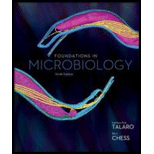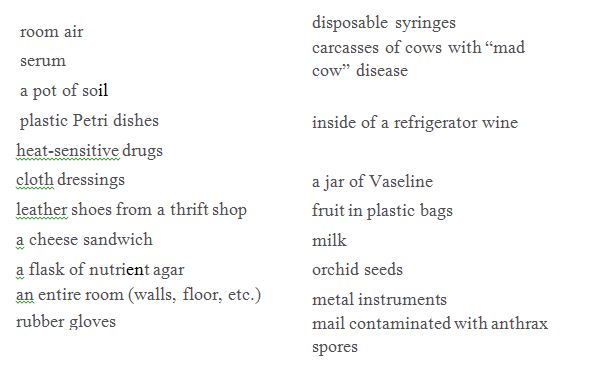
1. For each item on the following list, propose a reasonable method of sterilization. You cannot use the same method more than three times for the whole list. The method must sterilize, not just disinfect; and the method must not destroy the item or render it useless unless there is no other choice. After considering a workable method, think of a method that would not work. Note: Where an object containing something is given, you must sterilize everything (for example, both the jar and the petroleum jelly [Vaseline] in it). Some examples of sterilizing methods are autoclave, ethylene oxide gas, dry oven, and ionizing radiation

To determine:
The sterilization methods to be used for all the items give in the list.
Introduction:
There are several sterilization techniques which can be used. But, the technique to be used varies from object to object. Some of the sterilization techniques used are autoclaving, irradiation, filtration, chemical agents, etc.
Explanation of Solution
Different sterilization techniques need to be used for different types of objects. For examples, surgical instruments made of metal can be autoclaved but other plastic instruments and heat-sensitive medical device cannot be autoclaved. Instead they require irradiation or chemical sterilization. Sterilization technique for the objects in list are as follows:
| Sr.No | Object | Sterilization technique |
|---|---|---|
| 1 | Room air | UV radiation |
| 2 | Serum | Filtration |
| 3 | A pot of soil | Dry heat oven |
| 4 | Plastic petri dishes | UV radiation |
| 5 | Heat-sensitive drugs | Ethylene oxide gas |
| 6 | Cloth dressing | Autoclaving |
| 7 | Leather shoes from a thrift shop | Dry oven |
| 8 | A cheese sandwich | Irradiation |
| 9 | A flask of nutrient agar | Autoclaving |
| 10 | An entire room (walls, floors, etc.) | Chlorine dioxide |
| 11 | Rubber gloves | Autoclaving |
| 12 | Disposable syringes | Irradiation |
| 13 | Carcasses of cows with “mad cow” disease | Glutaraldehyde |
| 14 | Inside of a refrigerator | Ethylene oxide gas |
| 15 | Wine | Filtration |
| 16 | A jar of Vaseline | Ionizing radiation |
| 17 | Fruit in plastic bags | Ionizing radiation |
| 18 | Milk | UV radiation |
| 19 | Orchid seeds | Ethylene oxide gas |
| 20 | Metal instruments | Autoclaving |
| 21 | Mail contaminated with anthrax spores | Ionizing radiation |
Generally, all the techniques involving heat treatment would not be applicable for heat-sensitive product.
Different techniques need to be used for different objects, depending on their nature.
Want to see more full solutions like this?
Chapter 11 Solutions
Foundations in Microbiology
- 1. What is the hazard of the spattering tendency in heating a wire loop with specimens over a flame? 2. Why is heat a highly effective sterilizing agent?3. Which of the three methods of heat sterilization is the most appropriate and practical to use in sterilizing antibiotic solutions? (Direct flame, Dry heat, Moist heat)arrow_forward9. The process in which all organisms and pathogens are destroyed is called ------. a) Disinfection b) Sterilization c) Antisepsis d) Pasteurizationarrow_forward1-The method of sterilizations we used in the tissue culture lab a. Fumigation b. Filtration C. Autoclave d. Sun lightarrow_forward
- 1. The technique used in bacteria for endospore staining can also be used to observe fungal spores. Select one: True False 2. Which of the following statements is/are TRUE? a. Agar does not provide nutrients to microorganisms. b. Peptone, pork extracts, and yeast extracts provide nutrients to microbes. c. Tap water must be used for preparing culture media. d. A & B are correct. e. B & C are correct Clear my choice 3. Motility of microorganisms is BEST observed with a a. Flagellar stain b. Hanging drop preparation c. Solid medium d. Negative stain e. Streak plate Clear my choicearrow_forward1. Describe and give the principle of each equipment used for sterilization in microbiology. (refer to equipment drawn only)arrow_forward1. The Petri Dish method is used in microbiology to raise bacteria in: a) rapid growth b) pure culture c) septic environment d) all of the above 2. What is the difference between antiseptic and sanitization? 3. In order to prevent any kind of contamination the medium must be _________ before placing it in the Petri dish. a) lyophilized b) pasteurized c) autoclaved d) distilledarrow_forward
- 1. What is one advantage of utilizing the pour plate technique over the streak plate technique ? 2. Why must the agar pours be cooled to 45C before use in the pour plate technique? 3. Explain the consequences if a group removed all the agar pours from the water bath at one time and allowed them to sit on the bench for several minutes before using them. 4. Why can the agar pour tubes be rinsed in the sink after the agar is transferred to the Petri plate ? Could you rinse the tubes if the bacteria had been pipetted into the agar pour tubes rather than in the plates? Explain. 5. What would be the result if a student dipped his / her loop in the stock culture during inoculations of each quadrant ? Explain . part B 1. The introduction stated that microbes are mechanically separated or diluted over the surface of the medium . How is this accomplished ? 2. Go to https://commons.wikimedia.org/wiki/File:MacConkey_agar_with_LF_and_LF_colonies . . Which side of the plate (left or right)…arrow_forward3. Principles and methods of sterilizationarrow_forwardDefine disinfection. Compare/contrast it with sterilization, antisepsis and bacteriostasis. Give the modes of action of the different antiseptics/disinfectants used in the activity (5% sodium hypochlorite (bleach), 0.05% sodium hypochlorite (bleach), 70% alcohol, 40% alcohol, Iodophor (Betadine), and Mouthwash)arrow_forward
- which of the following is best to sterilize heat-liable (sensitive) solutions? a, pasteurization b. autoclave c. dry heat d. filration e. none of the abovearrow_forward1. Explain the effectiveness of 70% alcohol as antiseptic compared to the action of 40% and 95% alcohol. 2. Which is more effective as an antiseptic: ethyl alcohol or isopropyl alcohol? Choose only one and explain why. 3. Which is more effective as a disinfectant: ethyl alcohol or isopropyl alcohol? Choose only one and explain why. 4. What is the difference between cleaning, sanitizing, and disinfecting?arrow_forwardWhich of the following is false?a) A high-level disinfectant cannot be used as a sterilant.b) Critical items must be sterilized before use.c) Low numbers of endospores may remain on semicritical items.d) Standard sterilization procedures do not destroy prions.e) Quaternary ammonium compounds can be used to disinfect food preparation surfaces.arrow_forward
